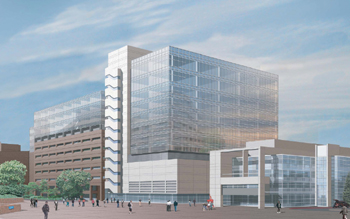
A rendering of MRB IV, which will be constructed on top of Light Hall and Langford Auditorium. (photo courtesy of Space and Facilities Planning)
Construction to begin on Medical Research Building IV in May
Vanderbilt University Medical Center has one of the fastest growing research programs in the nation, and it has quickly outgrown its research space. Soon construction will begin on MRB IV, a $110 million project that will provide more than 200,000 square feet of usable research area.
“We filled MRB III within months of the building opening,” said Dr. Jeffrey R. Balser, associate vice chancellor for Research. “This need for space, at minimum, speaks to the rapid growth of our research enterprise.”
Vanderbilt’s research program saw its extramural funding increase by 21 percent last year, due in part to Congress’ five-year plan to double the budget of the National Institutes of Health. The research program is three years ahead of plan in funding, and expects to continue to grow 5 percent to 7 percent annually. Increased funding means increased research activity, which translates into an increased need for research space.
“While our productivity with existing research space is among the highest in the country, it is clear that we will need additional capacity in order to expand our research programs at the pace that matches the high expectations of our faculty and departmental leadership,” Balser said.
Recognizing the achievements and goals of the research program, the Board of Trust approved the plans for MRB IV in late February. Construction on the building is set to begin in May and will continue over the next two years, coming to completion in summer of 2006.
The new building will be built on top of two existing buildings — Light Hall and Langford Auditorium. MRB IV will consist of three research floors added to Light Hall, and five research floors and two vivarium floors above Langford Auditorium. The project will also connect the two buildings, expanding both lobbies.
“Vertical expansion allows us to create additional research space, even when land is unavailable,” said Fred DeWeese, vice president of Planning and Development for Space and Facilities. “Besides this, the location will be convenient for researchers — it’s in the middle of campus, close to the hospital, clinics and other research facilities.”
MRB IV will be approximately the same size as MRB III, with similar floor plans and designs. It will have a total of 86 lab modules, along with conference space, and a glass atrium spanning several floors, serving as lobby areas.
“The facilities in this building will be state of the art, from the benches and furniture, to the design of the working spaces and core equipment areas,” Balser said. “It will also have an appealing design that encourages faculty to gather and informally share their ideas, and in this way, it reflects what is special about the character of Vanderbilt faculty.”
With the fourth medical research building, Vanderbilt will have added more than 1 million square feet of research space to the campus through the medical research buildings alone. Together, they will account for almost one-fifth of the total medical center building space.
“With MRB IV, Vanderbilt faculty will continue to enjoy some of the most exciting research facilities in the nation,” Balser said.
Construction Considerations
Though building MRB IV on top of existing buildings has financial benefits — no basement, shared heating and cooling systems, no land expense — it causes some inconveniences. The construction will not be taking place in a lot at the end of campus, but on top of the buildings faculty and staff work in or pass by every day.
“We’ve taken special considerations to make the construction go as smoothly as possible for those in and around the buildings we’ll be working on,” DeWeese said. “The crews will be doing a lot of night and weekend work to minimize the noise disturbances, and anything done to the utilities will be announced well in advance. There will be fencing in front of the buildings, with covered portals allowing access to the buildings. And netting will surround the buildings to protect those passing under from any debris.”
The most notable construction-related change for Vanderbilt employees will be the closure of the walkway between Eskind Library and Langford Auditorium, which currently serves as a major thoroughfare for faculty and staff parking in the 25th Avenue garage. Walkers will need to follow the same path the shuttle buses take, up 24th Avenue and down Garland Avenue.













